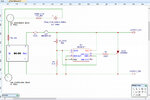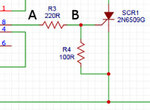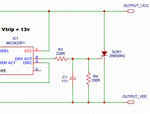pscammp
Newbie level 6
Hello all,
I need help with a crowbar circuit I'm currently constructing.
I am using some MC3423's (you don't see these very often anymore) as the basis of the circuit and the datasheet is as follows:
https://www.onsemi.com/pub_link/Collateral/MC3423-D.PDF
Circuit is based on the following schematic although 'R1' is replaced by a 50k variable pot:
https://www.google.co.uk/search?q=M...MAhUG1hQKHR2lAFEQsAQIKQ#imgrc=xbodhPXdUWl9iM:
I am also planning on using the following Thyristor to act as the crowbar device, datasheet again as follows:
https://www.farnell.com/datasheets/112558.pdf
Power to the crowbar circuit is supplied from the output of a variable Buck/Boost DC-DC converter set to output 12VDC and a 3A circuit breaker is on Vcc before the crowbar circuit, the voltage divider is set to get pin 8 on the IC to fire between 13.0v and 13.1v which has been fine tuned with the Pot in place of R1. Up to this point I have a 470 ohm resistor from Pin 8 to an LED and then to Vee purely as a visual indicator for the crowbar activating which has allowed me to get the trip voltage where I want it at approx. 13v.
I'm no electronics expert by far so here's my problem:
I have no clue how to work out what the value of the resistor 'Rg' should be to work with my chosen Thyristor. I see figures in the Thyristor's datasheet and the IC's datasheet but Pin 8 is pumping out around 12.38v when Vtrip is reached at 13.0 - 13.1v. From what I can see the Thyristor's gate wants only 1.0v (1.5v max) and 9mA typical.
I'm 80% lost here, it makes a bit of sense but I haven't a clue how to get there, the closest I could got was a 1.2K resistor which gives me 10.3mA (or does it ?) using Ohm's law I = V / R. But, is this right ? If it is then how does that 12.38v get below 1.5V for the Thyristor's gate ??
HELP !
Thanks so much for any help which may be offered
Paul
I need help with a crowbar circuit I'm currently constructing.
I am using some MC3423's (you don't see these very often anymore) as the basis of the circuit and the datasheet is as follows:
https://www.onsemi.com/pub_link/Collateral/MC3423-D.PDF
Circuit is based on the following schematic although 'R1' is replaced by a 50k variable pot:
https://www.google.co.uk/search?q=M...MAhUG1hQKHR2lAFEQsAQIKQ#imgrc=xbodhPXdUWl9iM:
I am also planning on using the following Thyristor to act as the crowbar device, datasheet again as follows:
https://www.farnell.com/datasheets/112558.pdf
Power to the crowbar circuit is supplied from the output of a variable Buck/Boost DC-DC converter set to output 12VDC and a 3A circuit breaker is on Vcc before the crowbar circuit, the voltage divider is set to get pin 8 on the IC to fire between 13.0v and 13.1v which has been fine tuned with the Pot in place of R1. Up to this point I have a 470 ohm resistor from Pin 8 to an LED and then to Vee purely as a visual indicator for the crowbar activating which has allowed me to get the trip voltage where I want it at approx. 13v.
I'm no electronics expert by far so here's my problem:
I have no clue how to work out what the value of the resistor 'Rg' should be to work with my chosen Thyristor. I see figures in the Thyristor's datasheet and the IC's datasheet but Pin 8 is pumping out around 12.38v when Vtrip is reached at 13.0 - 13.1v. From what I can see the Thyristor's gate wants only 1.0v (1.5v max) and 9mA typical.
I'm 80% lost here, it makes a bit of sense but I haven't a clue how to get there, the closest I could got was a 1.2K resistor which gives me 10.3mA (or does it ?) using Ohm's law I = V / R. But, is this right ? If it is then how does that 12.38v get below 1.5V for the Thyristor's gate ??
HELP !
Thanks so much for any help which may be offered
Paul



